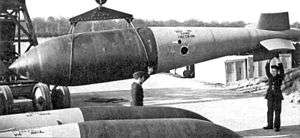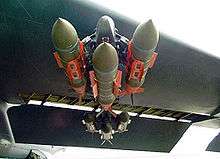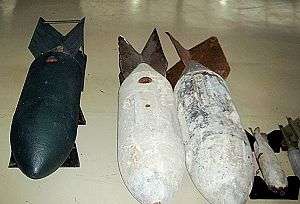Aerial bomb
An aerial bomb is a type of explosive weapon intended to travel through the air with predictable trajectories, usually designed to be dropped from an aircraft. Aerial bombs include a vast range and complexity of designs, from unguided gravity bombs to guided bombs, hand tossed from a vehicle, to needing a large specially built delivery vehicle; or perhaps be the vehicle itself such as a glide bomb, instant detonation or delay-action bomb. The act is termed aerial bombing. As with other types of explosive weapons, aerial bombs are designed to kill and injure people and destroy materiel through the projection of blast and fragmentation outwards from the point of detonation.
Early bombs
The first bombs delivered to their targets by air were launched on unmanned balloons, carrying a single bomb, by the Austrians against Venice in 1849.[1]
The first bombs dropped from a heavier-than-air aircraft were grenades or grenade-like devices. Historically, the first use was by Giulio Gavotti on 1 November 1911, during the Italo-Turkish War.[2]




In 1912, during the First Balkan War, Bulgarian Air Force pilot Christo Toprakchiev suggested the use of aircraft to drop "bombs" (called grenades in the Bulgarian army at this time) on Turkish positions.[3] Captain Simeon Petrov developed the idea and created several prototypes by adapting different types of grenades and increasing their payload.[4][3]
On 16 October 1912, observer Prodan Tarakchiev dropped two of those bombs on the Turkish railway station of Karağaç (near the besieged Edirne) from an Albatros F.2 aircraft piloted by Radul Milkov, for the first time in this campaign.[4][5][3][6][7]
After a number of tests, Petrov created the final design, with improved aerodynamics, an X-shaped tail, and an impact detonator. This version was widely used by the Bulgarian Air Force during the siege of Edirne. A copy of the plans was later sold to Germany and the bomb, codenamed "Chataldzha" ("Чаталджа"), remained in mass production until the end of World War I. The weight of one of these bombs was 6 kilograms. On impact it created a crater 4-5 meters wide and about 1 meter deep.
Technical description
Aerial bombs typically use a contact fuze to detonate the bomb upon impact.
See also
- Aerial bombing of cities
- Area bombardment
- Bomber
- Explosive weapons
- Strategic bombing
- Tactical bombing
Types of aerial bomb:
- Cluster bomb
- Concrete bomb
- Incendiary bomb
- General-purpose bomb
- Gravity bomb (dumb bomb)
- Guided bomb (smart bomb)
References
- ↑ Millbrooke, Anne (2006). Aviation History. Jeppesen. pp. 1–20. ISBN 0-88487-235-1.
- ↑ Grant, R.G. (2004). Flight - 100 Years of Aviation. Dorling-Kindersley Limited. p. 59. ISBN 9780751337327.
- 1 2 3 Capt Arthur H. Wagner Uscg (Ret), Arthur H. Wagner, Leon E. Braxton, Ltcol Leon E. (Bill) (2012). Birth of a Legend. Trafford Publishing. p. 27.
- 1 2 Who was the first to use an aircraft as a bomber? (in Bulgarian; photographs of 1912 Bulgarian air-dropped bombs)
- ↑ A Brief History of Air Force Scientific and Technical Intelligence Archived December 30, 2008, at the Wayback Machine.
- ↑ "The Balkan Wars: Scenes from the Front Lines". TIME. 8 October 2012. Retrieved 28 July 2015.
- ↑ I.Borislavov, R.Kirilov: The Bulgarian Aircraft, Vol.I: From Bleriot to Messerschmitt. Litera Prima, Sofia, 1996 (in Bulgarian)
External links
| Wikimedia Commons has media related to Air-dropped bombs. |

